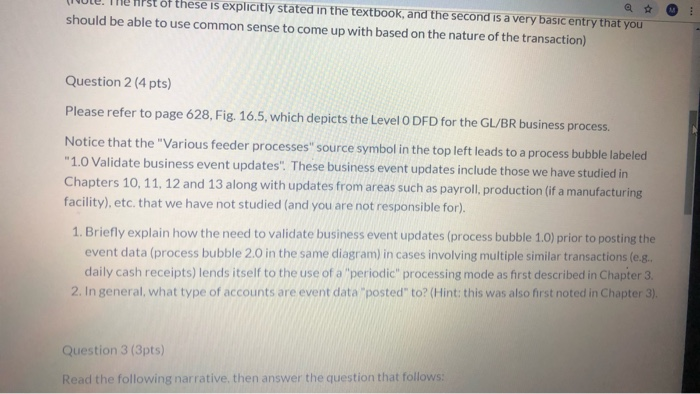HULL. The nest of these is explicitly stated in the textbook, and the second is a very basic entry that you Q should be able to use common sense to come up with based on the nature of the transaction) : Question 2 (4 pts) Please refer to page 628. Fig. 16.5, which depicts the Level O DFD for the GL/BR business process. Notice that the "Various feeder processes" source symbol in the top left leads to a process bubble labeled "1.0 Validate business event updates": These business event updates include those we have studied in Chapters 10, 11, 12 and 13 along with updates from areas such as payroll, production (if a manufacturing facility), etc. that we have not studied (and you are not responsible for). 1. Briefly explain how the need to validate business event updates (process bubble 1.0) prior to posting the event data (process bubble 20 in the same diagram) in cases involving multiple similar transactions (e.g.. daily cash receipts) lends itself to the use of a periodic processing mode as first described in Chapter 3. 2. In general, what type of accounts are event data posted" to? (Hint: this was also first noted in Chapter 3), Question 3 (3pts) Read the following narrative, then answer the question that follows: HULL. The nest of these is explicitly stated in the textbook, and the second is a very basic entry that you Q should be able to use common sense to come up with based on the nature of the transaction) : Question 2 (4 pts) Please refer to page 628. Fig. 16.5, which depicts the Level O DFD for the GL/BR business process. Notice that the "Various feeder processes" source symbol in the top left leads to a process bubble labeled "1.0 Validate business event updates": These business event updates include those we have studied in Chapters 10, 11, 12 and 13 along with updates from areas such as payroll, production (if a manufacturing facility), etc. that we have not studied (and you are not responsible for). 1. Briefly explain how the need to validate business event updates (process bubble 1.0) prior to posting the event data (process bubble 20 in the same diagram) in cases involving multiple similar transactions (e.g.. daily cash receipts) lends itself to the use of a periodic processing mode as first described in Chapter 3. 2. In general, what type of accounts are event data posted" to? (Hint: this was also first noted in Chapter 3), Question 3 (3pts) Read the following narrative, then answer the question that follows







